- You are here:
- Home »
- Mike Smith
Tag Archives for " Mike Smith "

Teaching Diving to the Ground
By Mike Smith –
“JUST FALL ON IT!!!!” I have carved out my coaching niche over the past 20+ years working with not just youth soccer – (U8 – High School) but also new or struggling teams and programs. One constant for me has been the need to “make” a keeper for almost every team I have ever coached. This high school season, I actually took over a struggling program whose only bright spot was a very talented sophomore keeper – who then tore his ACL playing baseball during the offseason and was not able to play soccer this year. Maybe it is me? Joking aside, ( and my keeper is recovering well and set to go next season ) I was once again tasked with making a keeper and fortunately found a talented athletic freshman who ended the season in the top 25 in the state for saves. He would have made more saves, especially earlier in the season, if he had of taken my initial advice – “ JUST FALL ON IT”.
For some keepers / keeper candidates, going to ground is easy ( and us coaches then coach them on not going to ground too quickly ) but for many – getting comfortable diving and smothering the ball takes some time, patience AND instruction. The main instruction points are footwork related and this lack of footwork shows up in games when keepers either don’t go all the way to the ground and cover the ball – which leads to easy saves slipping right through their hands ( or legs ) OR keepers making the dive but ending up facing the posts because they turned their bodies away from the ball and then dove. These are issues which can be “ drilled out” or good habits that can be “ drilled in “ during practice.
Set Up
For me, if a keeper isn’t comfortable on the ground, I get them comfortable by putting them on the ground. Start with two keepers / keeper candidates working together or with one keeper at a time and a coach serving the balls. The keepers are laying on their sides on the ground, one at a time saving, one at a time serving. The idea is for them to work on extending their ground ( bottom ) hand out along the ground, in line with the goal line, and having the top hand free for cover. This idea of bottom hand to ball, top hand for cover is important as the bottom hand’s shoulder ( range of motion ) is limited by the ground where the top hand’s shoulder is free – thus the top had has a greater range of motion.
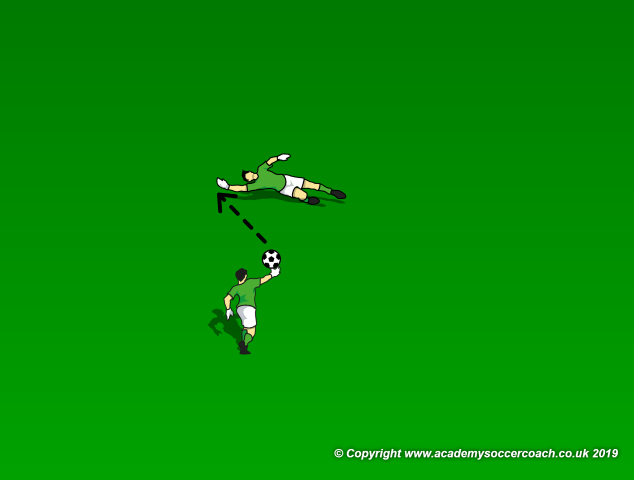
Once they have worked on the ground on both sides, they start on their bottoms, with their legs extended towards each other and repeat a similar progression – balls served on alternating sides low near the ground.
The next step is the critical point – working on the knees. This is where either the discomfort from being on their knees, or the realization being in a deep squat and going to ground isn’t much different from being on your knees and going to ground ( and is in fact more comfortable ) will flip the switch. Again, ( see below ) balls are served on alternating sides low near the ground.
2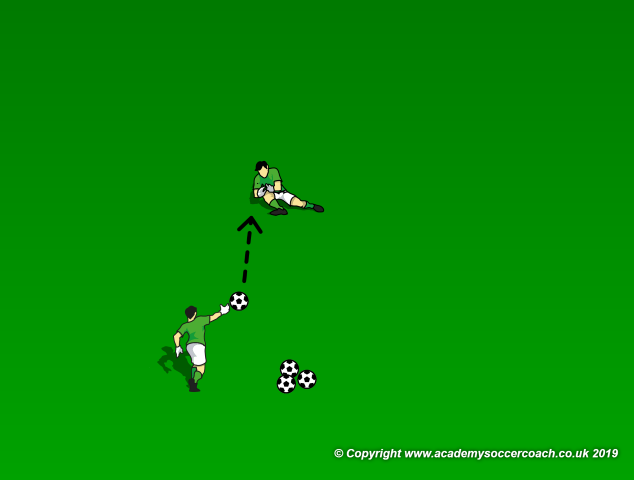
Progression
Bring in the shooters and see if the ground training has helped. Set up designated areas for the shots to go ( as shown below – target area is between the cones and posts) and let the keepers make saves.
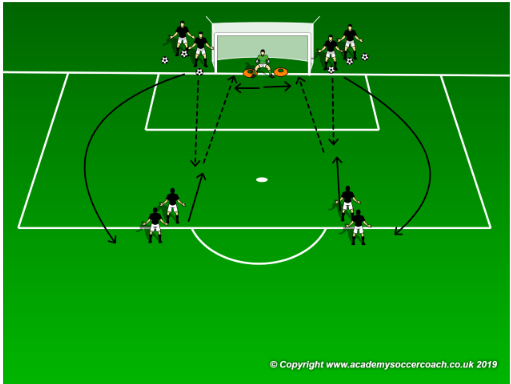
Coaching Points
The coach should focus entirely on the positioning, foot work and hand work of the keepers here. Are they shifting their weight and getting low first before the dive? Is their bottom hand extending and reaching first? ( I like to use this hand work as the idea of their bottom hand extending and “ leading them to ground” ) When they land are they extended across goal facing the field or facing the post? These are all critical factors in getting your keeper to JUST FALL ON IT.
By Mike Smith
Currently the Head Coach for University Heights Academy Boys Soccer in Hopkinsville, KY , Mike is in his 14th year as a high school head coach with 23 years coaching experience overall and 34 year as a student and fan of the game. He holds a USSF D License.
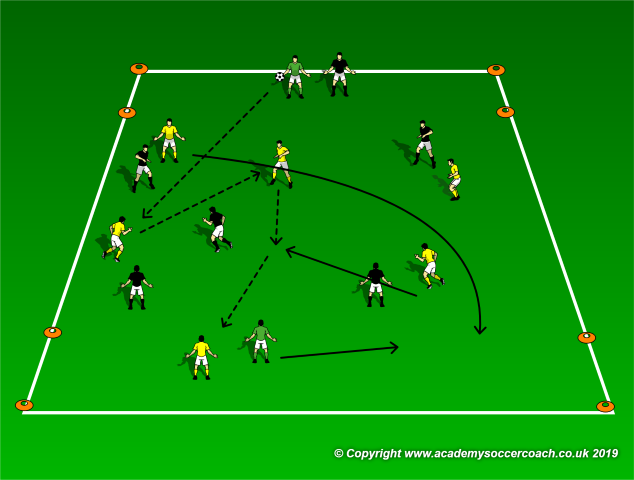
Team Handball For Goalkeeper Training
By Mike Smith –
When I was getting my USSF D License I remember the instructor saying “If you are working on defense, work on defense. Don’t worry about what the attackers are doing!” What the instructor (Coach Parrish ) was trying to do was make sure the coaches understood the need for clarity and purpose in training, basically staying on task. This is simple when the drill is simple, however there are tons of times when drills can be dual, triple and even quadruple purpose especially when they are game / scrimmage related. This is one of those drills. In an effort to make Coach Parrish happy however, I will ask those using it to focus only on the keeper work aspects of the activity.
We have all asked our keepers to “command the box” . I have found a great way to demonstrate / practice this is through team handball. (the other purposes are overall team work, movement off the ball and team communication ) Below is a demonstration of the game and the setup, along with some keeper specific aspects which can be used as a progression.
Set Up
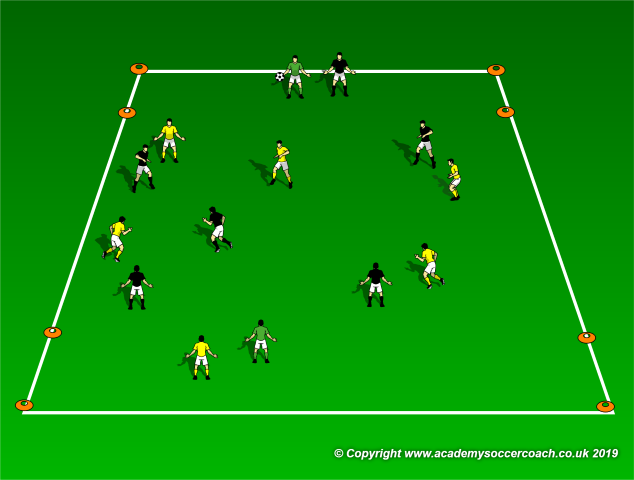
Set up a field approximately 20 yds wide and 40 yds long. The final 10 yd sections on each end are “end zones”. The keepers are the designated defensive players in each end zone. Play starts with the keeper serving a ball into a team mate who, don’t be shocked soccer purists, catches it in their hands. Once a catch is made, the player with the ball must stop moving, and has to pass to a team mate, who also must stop when the catch is made and pass. The ball cannot be slapped or taken out of the ball carriers hand and defenders must stay an arms length away to give room for the ball carrier to pass. The ball carrier has 5 seconds to pass or it is a turnover. Also, any balls which are not caught and hit the ground are turnovers, so the defending group does not have to intercept passes cleanly, just knock them down to the ground. All turnovers are left where the ball was given up or hit the ground. Goals are scored initially by sending a pass into the target player, who is defended by the goalie. Initially no other players are allowed inside the end zones but can switch out target players after a goal is scored.

The idea is for the keepers to read the field, and play the BALL when it is served in, not get caught up in the movement of the other players. After all, in a game, when the service is coming in, the keeper’s job is the ball. The diagram above shows how initially the keeper could get drawn away following an open player.
Progression
Once the keepers have the hang of it, release the target players to play the entire field and allow other field players to come into the end zones, but restrain the keepers to the end zones. In this progression, the keepers should not really have a mark and should be free to play the ball as in a real match.
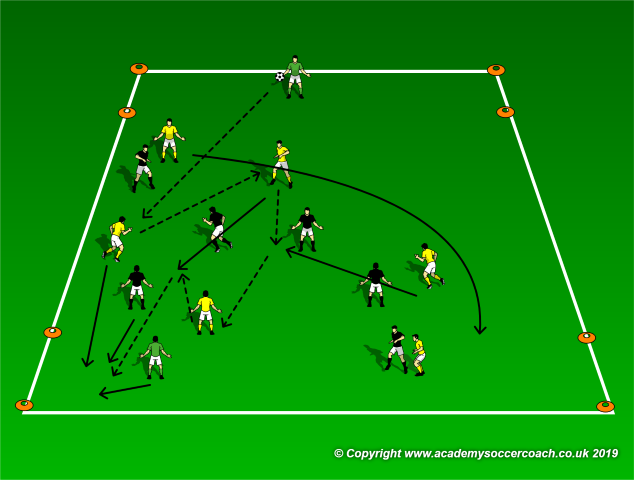
Coaching Points
The free play with the keepers restrained to the end zones should be the bulk of the exercise. Here the coach should make sure the keepers are reading the field, playing the ball, calling “KEEP” when going for the ball and making a good distribution afterwards. As a final progression, release the keepers from the end zones and let them play the entire field.
By Mike Smith
Currently the Head Coach for University Heights Academy Boys Soccer in Hopkinsville, KY , Mike is in his 14th year as a high school head coach with 23 years coaching experience overall and 34 year as a student and fan of the game. He holds a USSF D License.

Stopping A Near Post Cross
By Mike Smith –
Over the course of my coaching career I have struggled with a contradiction in my coaching style. Offensively, I swear by just getting the ball down the field and making a team eat crosses. This is my shotgun approach, just keep the ball going across the opponents net and good things will happen,( hopefully the middle will soften up when they step out to stop us from crossing). However, defensively, I find myself thinking – “ if I can just keep a team out wide and make them serve long crosses, and prevent shots from inside my box, we’re gonna win a lot of games.” The best offensive tactic cannot be the best defensive tactic can it?
One of the things I make sure of when employing my contradictory style is having a keeper who can stop the ball from actually getting across. I have found when making a team play crosses actually plays into the way your keeper practices stopping offense every day, it can be a winning combination.
Set Up
As a warm up, have a line of servers, one on each post of the goal for teams with two keepers, roll in balls to the keeper. This is a standard warm up activity for a lot of teams, where the servers roll balls in central, left and right progressing up from the ground, knee, waist, shoulder and above the head areas.
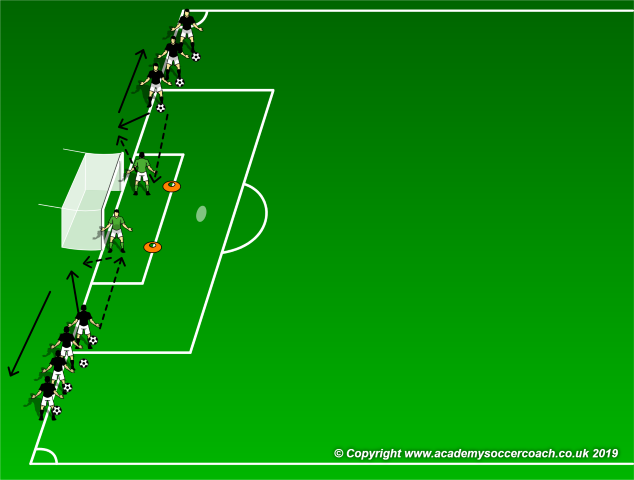
After this, have the keepers roll a ball out to the server, who must attempt to cross it through a cone gate, where the keeper must make the save with their hands. ( a finisher can be located on the back side for crosses that get through as a progression.)
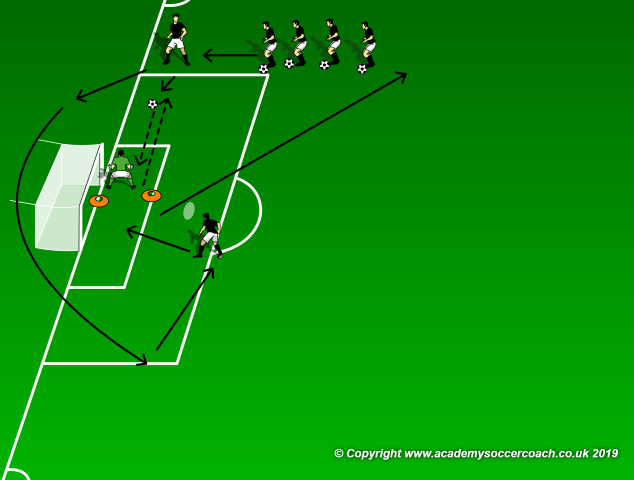
Final Progression / Coaching Points
Finally, set up a 3 attackers vs 4 defenders inside the box drill, with a 4th attacker free to hit a cross. Be sure to alternate crossing sides. The idea here is for the keeper to attempt to aggressively win crosses, so the coach should focus on good keeper positioning, communication and aggressively attacking the ball. As shown below, groups of 3 attackers play the ball from just outside the top of the 18 to the waiting service attacker. 4 defenders wait at the top of the 6 to pick up marks and defend the cross. While the serving attacker can serve from anywhere inside of 18 yards and all serves should go far post, the coach should make sure several services are made from deep and driven into the near post. After the service is made, the server may join the attack. Once the groups, and keeper, have gotten into a flow, make it a 4 v 4 activity inside the box, with the only requirement being all goals must be scored off a cross.
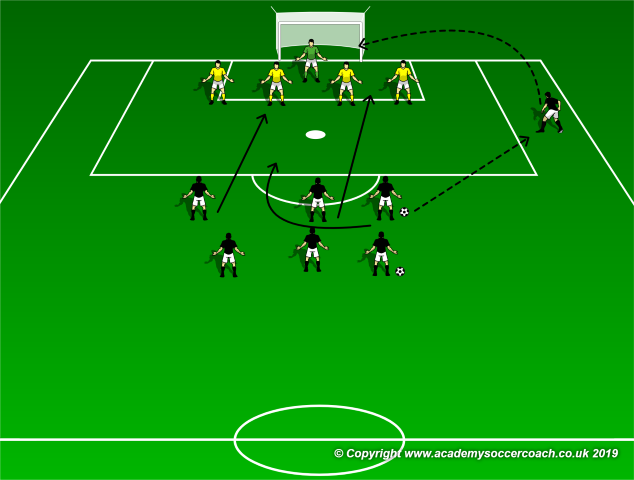
By Mike Smith
Currently the Head Coach for University Heights Academy Boys Soccer in Hopkinsville, KY , Mike is in his 14th year as a high school head coach with 23 years coaching experience overall and 34 year as a student and fan of the game. He holds a USSF D License.

Be a Distraction In Goal
By Mike Smith –
I was first introduced to the concept of being a distraction in goal through what I felt at the time was a poor choice of words. I actually always wanted to be a full time keeper but as I was always small – I was only 5 feet tall 100lbs when I graduated high school ( compared to my now towering 5’8 170lb frame ) -I never really earned any serious consideration. I was a decent striker so even though I was always destined for the field, I took every chance I could to get in goal and was designated as the emergency keeper as few times. This is where I was told to “ get big “. Getting big wasn’t my strong suit but when a coach explained further the need to simply distract the shooter, this made more sense. While “ getting big” was certainly a part of being a distraction, I found there were other ways to get a shooter off their mark as well, many which could be practiced.
Set Up
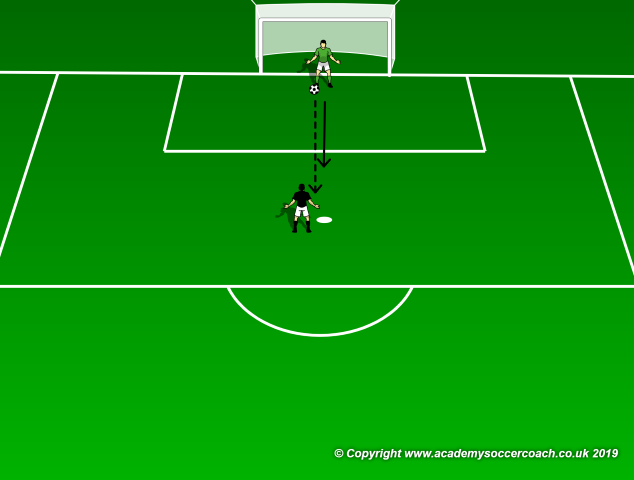
As shown above, one of the best ways to distract a shooter is just to shut down the space. ( I should note here, this can be a really fun and useful practice, but players should be encouraged to be careful and not get reckless when either charging or getting charged ). Let the keepers send a ball out to the pk spot where the shooter has 2 touches including the shot as the keeper closes them down. The keepers should get low, wave their hands and even yell as the shot is being taken. Just like in golf, a well timed “ AHHHHHHHH” can make all the difference in a perfect drive or a slice.
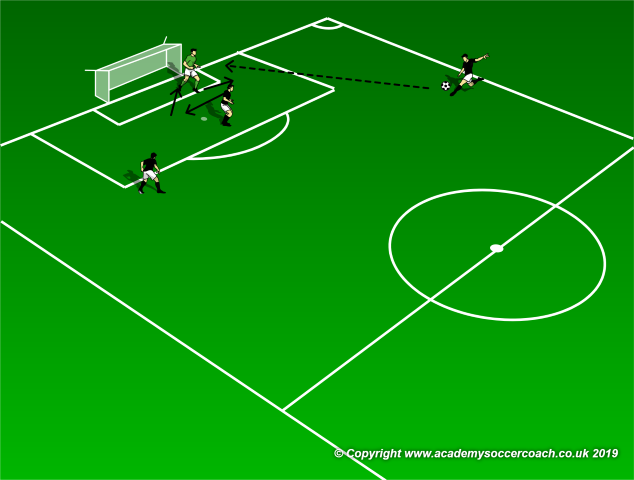
Another way to distract the attack in general is with some well timed movement. Too many times keepers get set up early for a cross and allow the near post runner to get too good of a read and run on the space. Without getting out of position, a keeper can move up, across and back and still be in position to make the save. This will throw off not only the shooter / server but also the attackers running in to finish. Set it up just as it is shown above and try it. Free service to a near and far post run. With a more active keeper, the scoring percentages will go down.
Finally, as shown below, a vocal keeper will always be a distraction and while I don’t condone trash talking, a bit of honest trickery doesn’t hurt. What I mean is, keepers always seem to yell “ AWAY” or “ CLEAR” or “ KEEP” while attackers seem to yell “ HAVE IT” or “SHOT” or “LEAVE”. Both sides seem to use “MINE” but in a box with 20 players in it, just who is “MINE” is not always clear. I have seen keepers ( mine included ) stifle a wide open shooter by yelling “LEAVE” as they pounced on the cross. Dirty pool? Not in my opinion. Again, set up a finishing drill with a near and far post run and with out telling the attackers, have the keepers yell out common attacking words to see if they can throw off the shooters a bit.
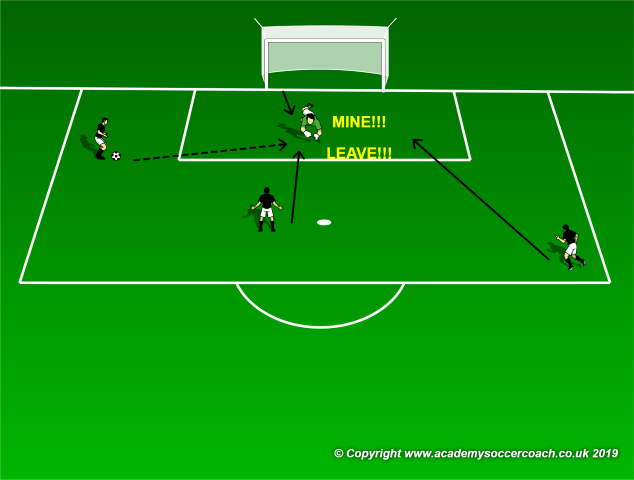
Coaching Points
This is a great change of pace practice for the entire team, but the tenants are useful. In addition to waving arms and a wide stance ( getting big ) a keeper who isn’t afraid to come out on a shooter and close down the space, take up the finishing space with movement on services and use vocal cues and deception will come up with a few cleaner sheets than one who doesn’t. The coach should work through these activities first and then use a half field scrimmage or corner kick drill to put the idea of being a distraction into play.
By Mike Smith
Currently the Head Coach for University Heights Academy Boys Soccer in Hopkinsville, KY , Mike is in his 14th year as a high school head coach with 23 years coaching experience overall and 34 year as a student and fan of the game. He holds a USSF D License.
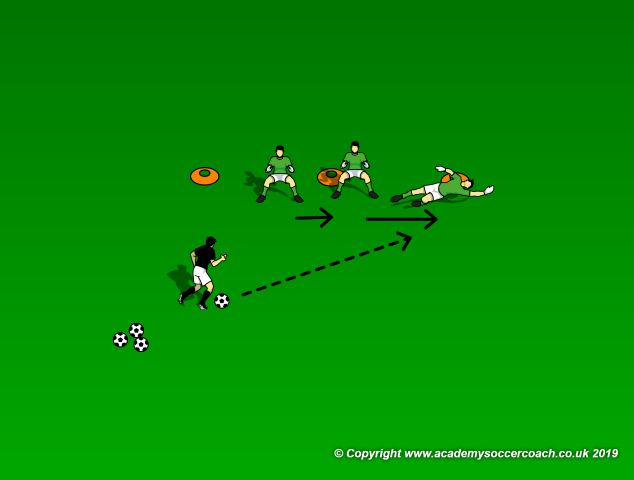
How to Extend a Goalkeepers Reach
By Mike Smith –
Just as most field players have a dominant foot, most keepers have a dominant leg they prefer to push off from. This usually corresponds with the dominant foot so if your keeper is right footed, chances are they prefer to launch from their right leg. I teach my keepers to shift their weight to the “ inside “ foot i.e. the foot closest to the ball. This actually helps with going to ground quickly but also puts the keeper up to 2 feet closer to the ball when going for wider shots. In right foot dominant keepers IF there are always more misses on shots taken to their left side, it could be a problem with holding their weight on their dominant leg. Take some time at practice to identify your keeper’s dominant foot and then make sure they are shifting their weight to the less dominant side when needed to help them extend their reach.
Set Up
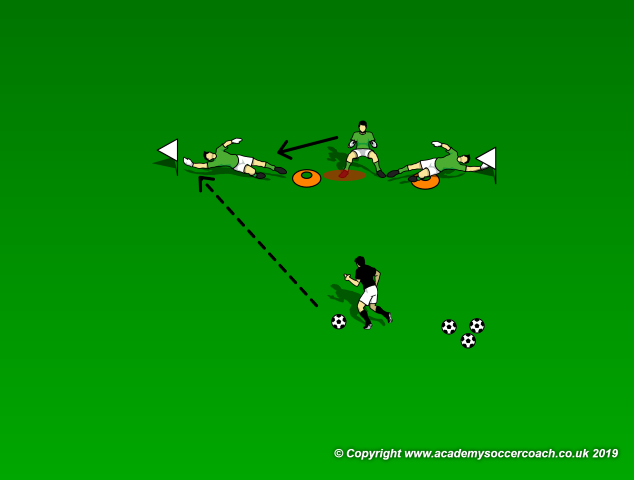
Place a couple cones 3 ft apart and have your keeper(s) start from the middle. Have a shooter or coach send a few shots wide to the goalies right and mark the edge of their reach. Repeat this on the left side and see if there is a difference. Many times, especially in the youth ranks, the keeper can cover a greater distance when their dominant leg is the inside leg.
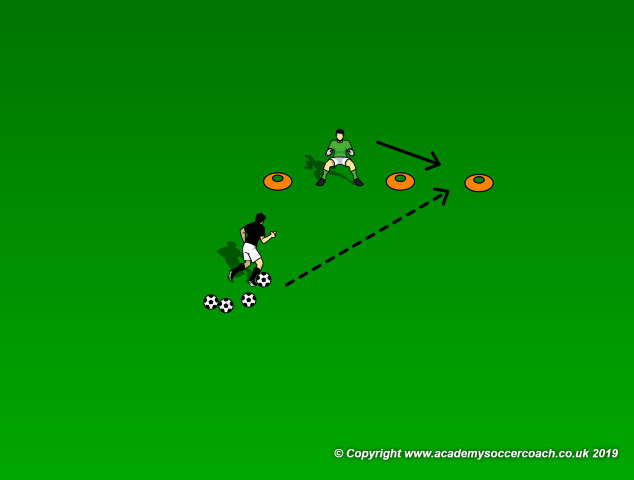
As shown above, work on increasing the distance covered on the non dominant side. This should be done from a traditional sense to increase the strength and distance on the non dominant side, but there is also power in recognizing which side is non dominant as the keeper can also use a shuffle step when facing shots from their “ weaker” leg.

Have the keepers shuffle to the edge of the 3ft cone before making their dive. By recognizing their weak side the keeper can be trained to take that extra step until 1. They strengthen their weak side and 2. They add the shuffle step to their strong side as well thus increasing their reach even more.
Coaching Points
A full fledged shooting drill can end this session to help mark improvements in a match like setting. The coach should use this as a developmental and tactical tool to help their keepers develop individually but also be tactically aware of how to compensate for their weaknesses and play to their strengths. Solid weight transfer and the shuffle step should be the focus of all the coaching here.
By Mike Smith
Currently the Head Coach for University Heights Academy Boys Soccer in Hopkinsville, KY , Mike is in his 14th year as a high school head coach with 23 years coaching experience overall and 34 year as a student and fan of the game. He holds a USSF D License.
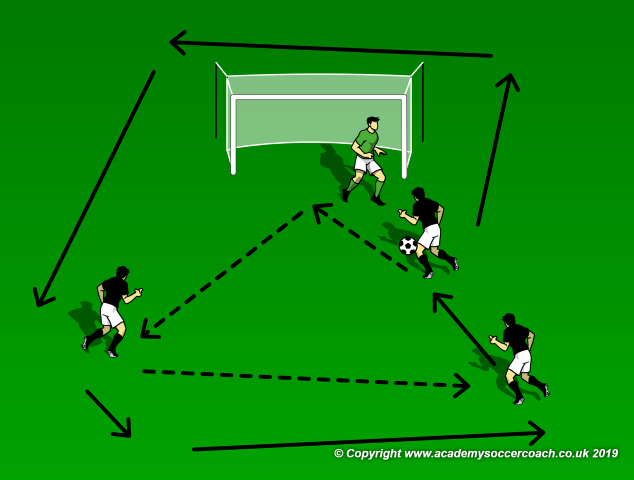
Saving the Ball With Your Legs
By Mike Smith –
Maybe not every game, but certainly every season I have ever been a part of I can remember a great kick save or two. I actually had a keeper several years ago who routinely pulled off amazing kick saves,( most of the time at the expense of the more fundamental text book save) but since he was the only player who would step up and get in goal in a year where I started 7 players on my varsity squad who had never played soccer, I rolled with it. In fact, it was that year I decided to actually practice kick saves with all my keepers as I found it was something many coaches and teams neglected. I discovered a couple sessions each year on kick saves will pay dividends every season, and is usually a fun change of pace for the keepers.
There are two common scenarios where the kick save comes into play: 1. A stab from the standing position when the ball comes into view quickly on the unexpected side, including with deflections and 2. After the keeper has committed to a dive and the ball skips or bends or is deflected past the hands but still across the body to the opposite side. Both these situations can be practiced.
Set Up
As shown below, 3 “attackers” set up to attack the near post but then roll the ball into the far side netting. To start, the balls should come where the keeper can easily “stab” their foot out to deflect the shot. Hopefully, the keeper can slide their foot under the ball causing it to go as high as possible. An attacker is positioned to receive this deflection and pass it to the next shooter. The shooter rotates around the back of the goal to the deflecting position. As the players get a feel for it, have the pace quicken. The shooter can also be given the option to shoot near post as a progression which will force the keeper to stay focused on the traditional save as well as the stab.

Progression
While the stab is not the optimal saving technique, the actual kick save can be. As shown below, have the shooters send a ball into the keeper so the ball can be trapped into the chest. As this is happening, have another keeper throw a ball in which must be kicked away, again, as high as possible.
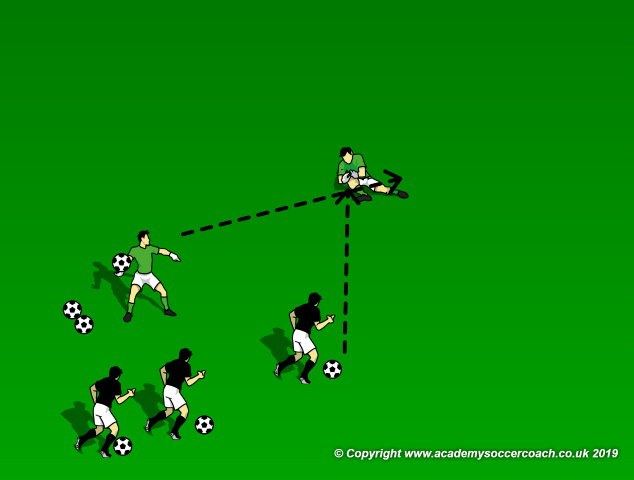
Progression
Finally, position 4 shooters as shown below. The first ( 1 ) shooter takes a shot RIGHT AT THE KEEPER from the PK spot. The keeper holds onto this ball. The second shooter ( 2 ) rolls a ball in on the ground which the keeper must pop up as high as possible. The keeper then drops the held ball and receives a shot from the third shooter ( 3 ) which they must go to ground to save. The keeper holds onto this ball as they will immediately need to make a kick save from a shot from the fourth ( 4 ) shooter. IF the shooters are not accurate enough the balls may be thrown in to start until the keeper has had several reps at each station. When the actual shooting starts, if every shot isn’t perfect so be it, not every shot in a game will be perfect as well and this will also help shooting accuracy on the attacking side. Groups of 4 shooters can rotate in and out to make this a full team activity.
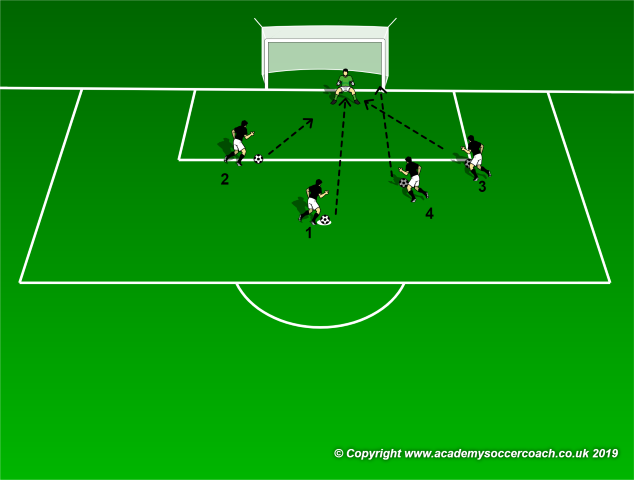
Coaching Points
This is a good change of pace drill to help keepers understand all their options and make sure they are in position to do whatever it takes to keep the ball out of the net. The coach should make sure the keepers feet are active and not flat for the stab save and make sure when the keeper goes to ground the top leg is ready to kick at anything which may get past, this will pay off on match day.
By Mike Smith
Currently the Head Coach for University Heights Academy Boys Soccer in Hopkinsville, KY , Mike is in his 14th year as a high school head coach with 23 years coaching experience overall and 34 year as a student and fan of the game. He holds a USSF D License.
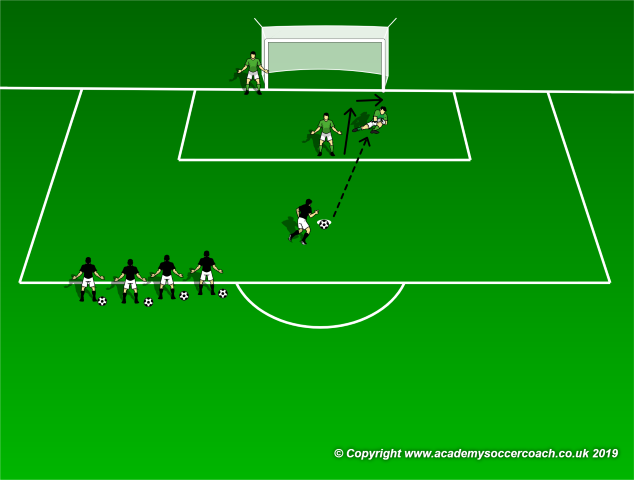
Getting Your Chest on the Ball
By Mike Smith –
“ You play goal keeper with your feet, not your hands.”….. “ And really, you are trying to get your chest to every ball.” These two statements rocked my youthful understanding of goal keeping as at 10 years old I was really really sure being a goalie was all about using your hands. What my coach was trying to get out of me was a simple improvement many of us can get out of our keepers, especially young ones: better footwork and increased range of motion from the arms – plus, the ability to safely smother a few more shots rather than bat them back into the danger zone.
Just like the goal of every academic test is to get 100%, the goal of every save is to be in position to trap the ball safely into the chest and start the possession going the other way. Just like testing, the 100% isn’t always going to happen, BUT if 100% is the goal there will be far more A’s and B’s than C’s and D’s. In the net, if the goal is to get every ball to the chest, then those near misses from poor footwork and those flubbed rollers from not going all the way to ground will turn into saves. I guess in sports this improvement is like going from an F to an A in the classroom. Simple concept, often overlooked but will yield big gains if given some work.
Set Up
As shown below, have a couple keepers work together moving side to side, up and down and forward. To start off the balls are thrown. The idea is to bring the ball into the chest, from directly in front of the chest. Make sure the keeper making the save is pushing off the inside foot and taking the extra step to get their chest to the ball, not just leaving from where they start ( between two cones place about 3 ft apart).
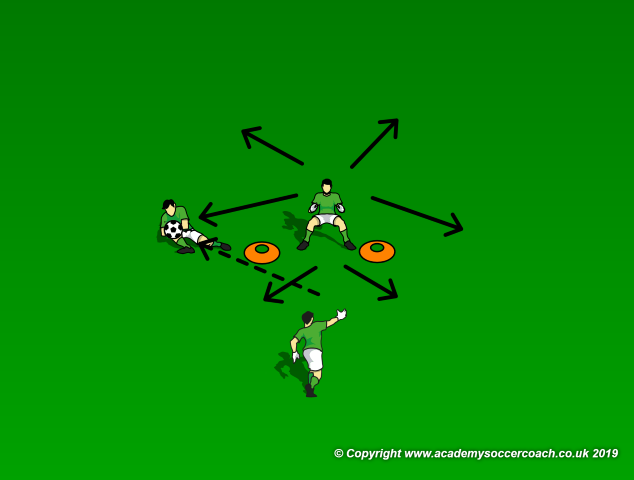
Progression 1
Next, bring on your 4 -6 best shooters and practice as shown below. The shooters start at the penalty spot and the keeper starts at the top of the 6. When the keeper starts to back pedal the striker takes a shot to the corner. To start, the shooter will tell the keeper where the shot is going. At the moment the ball is struck, the keeper should commit to trying to trap the ball into the chest. As a warm up for the shooters, the shots should initially come at ½ to ¾ pace so the keepers can get to their chests completely to them. Keepers rotate every 4-6 shooters and after each rotation the speed and pace should increase.

Progression 2
As shown below, change the format a bit to involve a service across the box to a shooter who will attack the near post but then send the ball across for either a far post shot or finish to a crashing attacker. The goal is the same, smother the cross. While the diagram shows this happening on the ground, it can also happen in the air. This is perhaps the most game specific need for this skill as winning a cross cleanly both stops an attack cold but also sets up an almost definite counter. Groups of two can rotate in on multiple keepers.
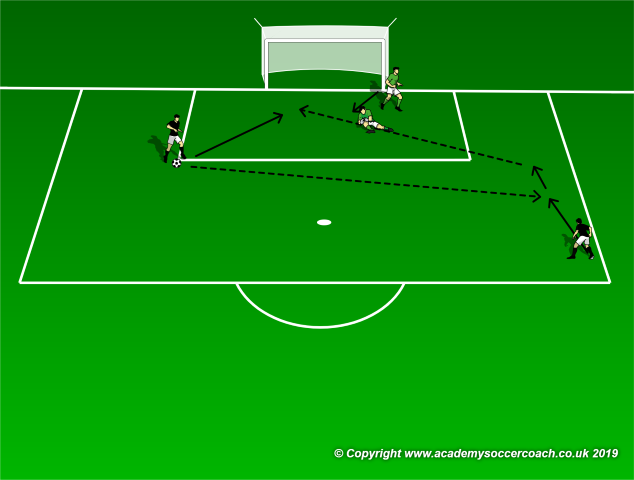
Coaching Points
By default this drill will put the keepers in better position to make all types of saves because if they are getting their chests closer to the ball they will have increased range of motion with their arms. However, the added focus on the footwork and taking that extra inside step to get the chest there will result in fewer “flubs” and second chance goals all while creating more counter opportunities. The coach should focus the keepers on the overall goal and proper footwork during all 3 activities.
By Mike Smith
Currently the Head Coach for University Heights Academy Boys Soccer in Hopkinsville, KY , Mike is in his 14th year as a high school head coach with 23 years coaching experience overall and 34 year as a student and fan of the game. He holds a USSF D License.
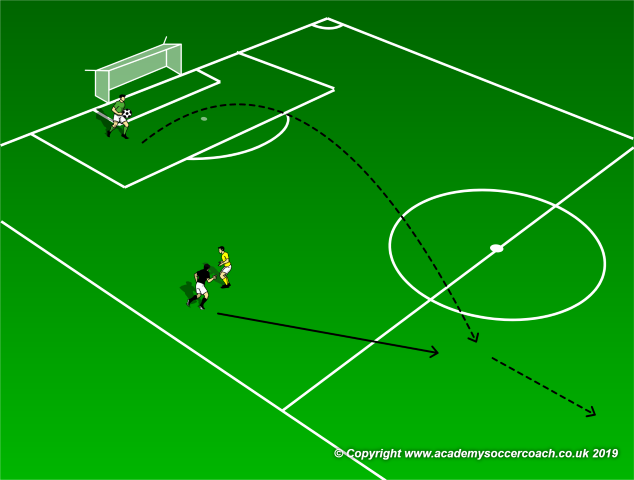
The Perfect Goalie Punt
By Mike Smith –
I am taking over a new program this fall, one which has struggled with coaching consistency and on field performance. This has me thinking about many of the simple things I have used to help players improve quickly over the years. In a perfect world, my keeper would not punt the ball but roll it out to an open player, who would start a chain of 5 – 7 passes to feet which would result in a service which beats the keeper for an open player to simply finish in an open net somewhere inside the 6. I have yet to spend more than a few fleeting seconds in that perfect world. In the middle school, junior varsity and even varsity ranks I always encounter the keeper who can punt it past half field effortlessly so in turn, this has been used as “ instant offense” – with the caveat the higher the punt the better.
As long as this punting does not come at the expense of the keeper’s overall soccer experience as a whole, I will admit to embracing some punting. In fact, a quick area punting can be improved on is getting the keeper to understand when to loft the ball ( the most common natural result of a keeper punt ) and when to arc the ball. The overriding principal is to get the keeper to start considering how their target player needs to receive the ball and / or which type of distribution is best in the given situation. Here are some examples:
LOFT
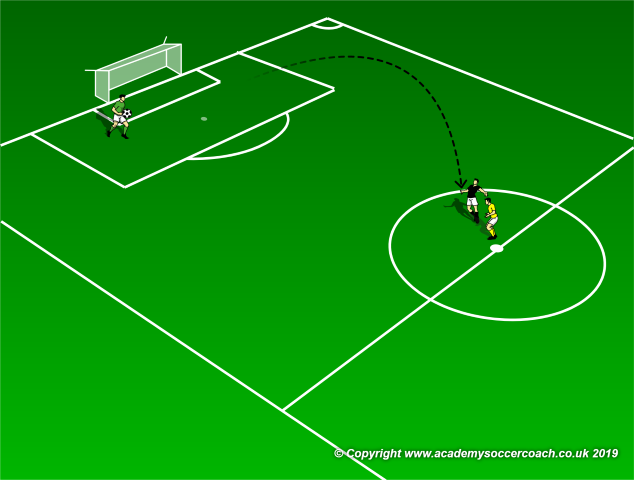
IF your side is better in the air. IF you just want to kill some time. IF you are trying to compact the opponent in a certain area then a lofted punt is fine. This is the most common type of punt, “ Just get it to the half line”. However, a simple punt can be a glorified clearance ( i.e. give away ) and the same instructions coaches give defenders for clearances – HIGH and WIDE, are often the same as they give goalies for punting as a distribution.? This is where the idea of arc comes in.

If you need a quick counter or your opponent holds a high line, or even if you just have speed on the wings, teaching your keepers to arc their punts – which have a flatter trajectory, spend more time going forward and will run out instead of bounce when the hit the ground – will be of benefit.
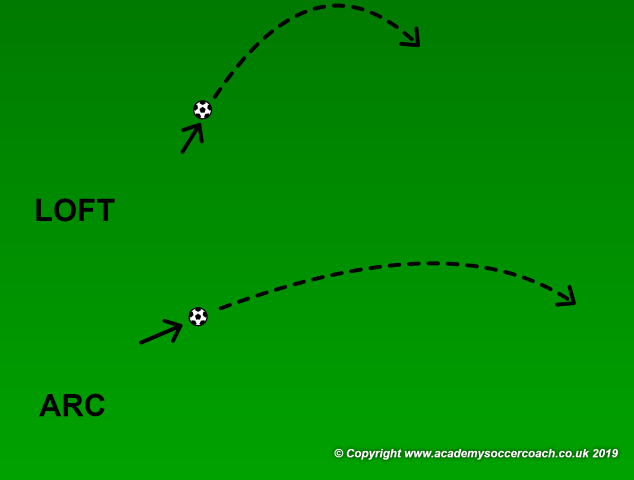
As shown above, a basic understanding of foot placement is all which is required to change loft into arc. Loft is achieved by hitting the bottom of the ball with just a bit of forward momentum. Arcing the ball requires hitting it low, but more towards the back of the ball and with more forward momentum. Yes, height allows gravity to help distance but unless you are playing against 10 footers, 10 or 12 feet of height is great to make sure the ball hits going forward for your target player to find on the run.
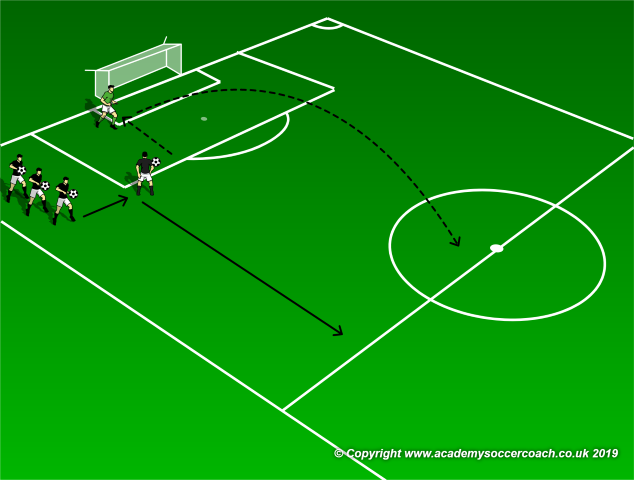
Set Up
Not being one to over complicate things, to work on this, simply work on it. After the keeper has warmed up, kicking into the net is always a good warm up, have players walk up, pitch the ball to the keeper ( as shown above ) and then turn and go. The coach can designate whether the balls are all arced or all lofted, or allow the chasing players to call it out as they pitch the ball to the keeper. Doing both actually makes a good progression.
Coaching Points
This is a simple concept, but will pay off in games and more importantly, add to the overall development of your keeper. This is especially impactful for those keepers who can already knock it to the moon. Get a bit more forward arc on those and with a speedy forward, those lofted punts can turn from glorified clearances to bona fide counter attacks.
By Mike Smith
Currently the Head Coach for University Heights Academy Boys Soccer in Hopkinsville, KY , Mike is in his 14th year as a high school head coach with 23 years coaching experience overall and 34 year as a student and fan of the game. He holds a USSF D License.
